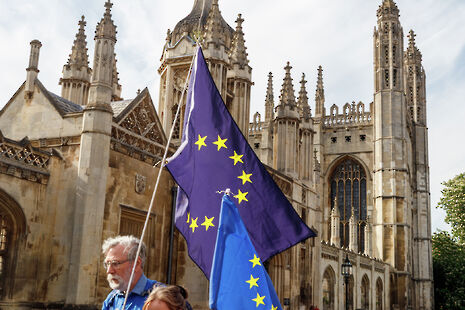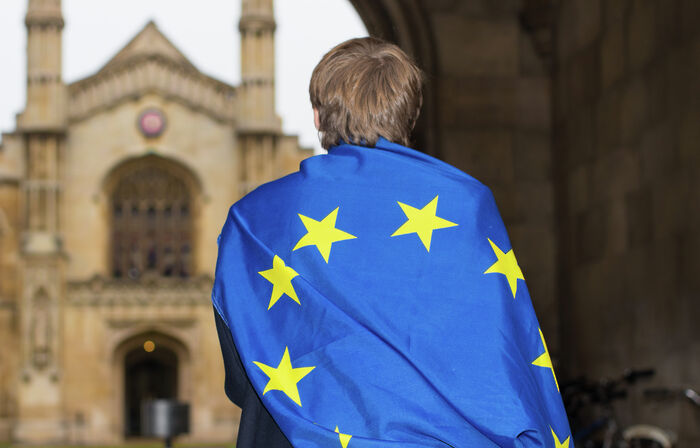Cambridge sees sharp fall in applicants from EU
Recently-released admission statistics show the 2017 cycle had the lowest number of EU applications since 2013 in period of post-Brexit uncertainty

Newly-released admissions statistics have revealed that the recent upward trend in Cambridge applications from the EU may now be in jeopardy, with the first drop in applications since the 2011 tuition fee hike.
Just 2,389 EU students applied out of a total 17,189 Cambridge applications in the 2017 admissions cycle – a 12.5% decrease from the 2016 applications round. This fall in applications comes against continued uncertainty over the fee status for EU students.
The University’s 2017 admissions cycle saw its lowest absolute number of EU applicants since 2013, and its smallest share of EU applicants since at least 2011. Annual admissions statistics published by the University prior to 2011 did not include breakdowns of overseas applications by country or region.
The annual International Student Survey, which was conducted by QS Enrolment Solutions, found that Brexit had deterred almost two-fifths of prospective UK university applicants from the European Union.
Although the University of Cambridge has confirmed that EU students starting their degree in 2018 will pay home student fees for the duration of their course, the status of 2019 applicants still remains unclear. Nearly one-third of EU respondents to the International Student Survey were not aware that students starting degrees in Britain in 2018-19 will pay the same fees as domestic students for the duration of their course.
Last year, a report by the Higher Education Policy Institute, an education think tank, estimated that EU student numbers at UK universities would drop by as much as 60%.
Overseas students made up 25.3% of acceptances, continuing a positive trend seen over the past three years. Applicants from China and Hong Kong were both at their highest level this year since at least 2011.
The University of Cambridge also admitted 64.1% of its incoming student body from the maintained sector in 2017, rising from 62.5% in the 2016 cycle and breaking the University’s previous record for state school intake, in 2012.
The school-type admissions breakdowns reveal, however, continued disparities in state school intake across colleges. 76.5% of Churchill’s acceptances came from state schools, the highest of any of the undergraduate colleges, followed by Trinity Hall, with 75.3%. In contrast, 48.6% of students at St John’s and 52.2% of Gonville & Caius acceptances hailed from the maintained sector.
Regarding the figures, a spokesperson for the University of Cambridge noted that it “spends around £5m a year on outreach activities”, including “residential stays at Colleges, open days and visits to schools across the UK”. The University has also recently announced that it will implement ‘foundational’ programmes for educationally-disadvantaged students by 2020.
The number of students admitted from POLAR3 Quintile 1 – areas in the UK with the lowest participation rates in higher education – rose from 3.3% to 4.6% in 2017.
For the 2017-2018 admission cycle, the now disbanded Office for Fair Access had set the University of Cambridge targets to accept 62.7% from state schools and 11.5% from POLAR3 Quintiles 1 and 2, both of which it reached.
Despite the University having made moderate gains in state school and regional access for the past admissions cycle, the Higher Education Policy Institute published a report this week calling for both the University of Cambridge and Oxford to establish new colleges in order to boost student diversity and improve success rates for under-represented groups.
 News / Cambridge academics stand out in King’s 2026 Honours List2 January 2026
News / Cambridge academics stand out in King’s 2026 Honours List2 January 2026 Interviews / You don’t need to peak at Cambridge, says Robin Harding31 December 2025
Interviews / You don’t need to peak at Cambridge, says Robin Harding31 December 2025 Comment / What happened to men at Cambridge?31 December 2025
Comment / What happened to men at Cambridge?31 December 2025 News / AstraZeneca sues for £32 million over faulty construction at Cambridge Campus31 December 2025
News / AstraZeneca sues for £32 million over faulty construction at Cambridge Campus31 December 2025 Features / “It’s a momentary expression of rage”: reforming democracy from Cambridge4 January 2026
Features / “It’s a momentary expression of rage”: reforming democracy from Cambridge4 January 2026










